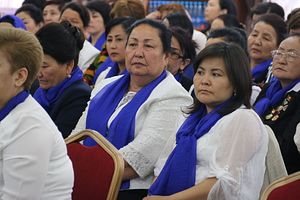Earlier this month, Kyrgyzstan’s Committee on Constitutional Legislation approved a draft law that proposes a 30 percent gender quota in the country’s local councils.
The law was first introduced in parliament last December, with UN Women’s branch in Bishkek and the Organization for Security and Cooperation in Europe (OSCE) providing support. If this law makes it past a third reading, it will add to broader legislation intended to bolster gender representation across Kyrgyzstan. Other efforts to bring Kyrgyzstani women into the policymaking process include 30 percent quotas for civil service and party candidate lists in national elections, introduced in 2002 and 2007, respectively.
Experts recognize that quotas are not permanent solutions to gender inequality, but rather are temporary measures to help women overcome social and economic barriers to participating in government. The idea behind reserving spots for women is that once a sufficient number of women hold positions of power, laws will be fairer and more attentive to gender-specific issues.
Social science research offers evidence for the latter justification. A study conducted by Raghabendra Chattopadhyay and Esther Duflo in 2004 found that gender influences policy priorities: Indian village councils headed by women invest in public goods linked more closely to women’s concerns, like water, while men in charge of local councils pushed for education.
Regardless of the intention behind gender quotas, the jury is still out on whether they are effective. What exactly “effective” means, though, depends on the cultural context and time horizon. Recent research tracking women’s representation in India over time has suggested several mechanisms by which gender quotas could be judged.
First, quotas tend to mean more women in power, and studies have found that exposure to female leaders reduces bias in how people perceive women’s effectiveness in positions of power.
Second, quotas have a lasting positive effect on women’s representation because of the way they introduce a group of women candidates who are able to run and win elections even after quotas lapse. When women win an election with the help of a quota, they push back against stereotypes held by the voting public, by parties who worry that women aren’t attractive candidates, and by families that might be unwilling to let a mother, daughter, or sister run for office. Shifts in those stereotypes have lasting effects, according to a 2009 study that also uses data from India’s village council elections.
In spite of the theory supporting gender quotas, some are concerned that they are little more than cosmetic attempts to solve problems of representation. Bridging the gap between policy and practice constitutes a major challenge to achieving a meaningful impact with gender quotas.
In Kyrgyzstan, gender quotas have been criticized because of the time frame they target. The quotas apply to candidate lists at the time of registration but do not extend to actual distribution of seats following an election. This means that a party might meet quota requirements when registering their candidate list, but fail to hit the intended 30 percent threshold after an election because women candidates are moved down the list or withdrawn entirely. In 2015, while individual party lists registered more than 30 percent women, only 20 percent of newly elected parliamentarians were women.
More perniciously, some worry that gender quotas could undermine the goal of gender parity in government. Setting a 30 percent quota could mean complacency with 30 percent representation. Moreover, a seat at the table does not guarantee equal decision-making opportunities. While women can be numerically represented in legislatures, journalist Farangis Najibullah has pointed out that “they are virtually nonexistent in power ministries like those of law enforcement, energy, defense, or foreign affairs.”
Of course, legislated guarantees for women’s representation are not magic bullets for social change. Directed trainings for potential candidates on electoral procedures and running a campaign (like those led by UN Women and the UN Development Program in Kyrgyzstan), conferences that foster opportunities for networking and mentorship, and sustained media attention are also important.
Even if the proposed gender quota for village councils does not work exactly as intended, inaction is not an option. In March 2019, former President Roza Otunbaeva called out the utter lack of women’s representation in local politics at a conference on rural development. “During the National Dialogue on Regional Development, 1,200 men filled up the Philharmonia. It seems that only men speak for the regions,” Otunbaeva said.
Indeed, at the local level, the number of women deputies in Kyrgyzstan’s village councils has not exceeded 11 percent in the last three years. In fact, one in five village councils in Kyrgyzstan has no women representatives at all.
If the proposed law makes it past a third and final reading in parliament, it gives hope that women will be more involved in crafting decisions that affect everyday citizens’ lives more than national debates. While Otunbaeva’s presidency was historic and Kyrgyzstan’s parliament may have a higher proportion of women representatives than Western countries like the United States and France, local politics are also consequential. This is especially true in a country like Kyrgyzstan, where policy is drafted and implemented in a less centralized manner than neighboring states.
































